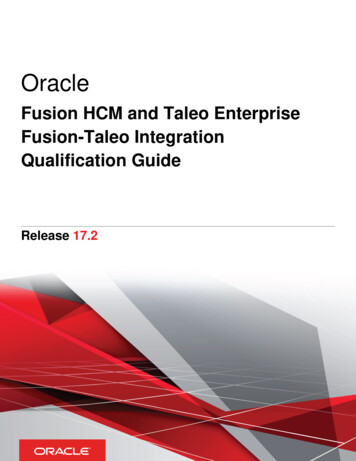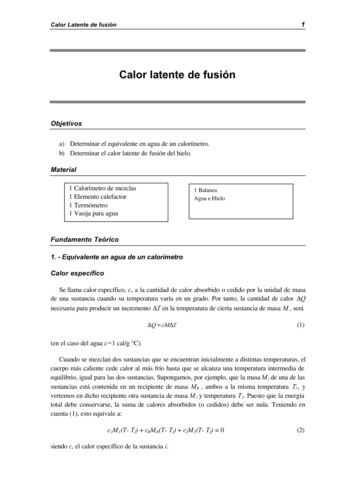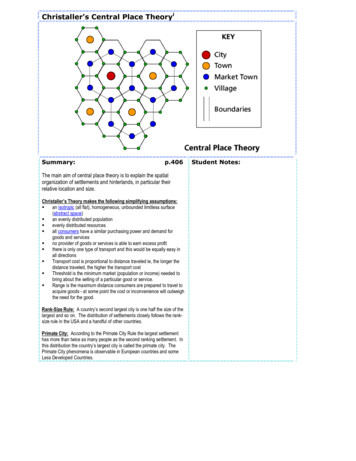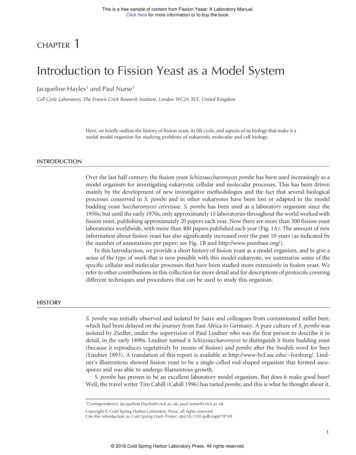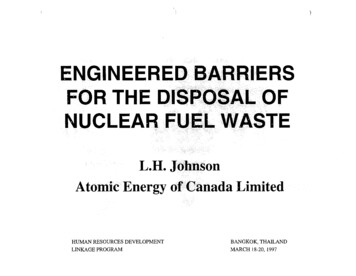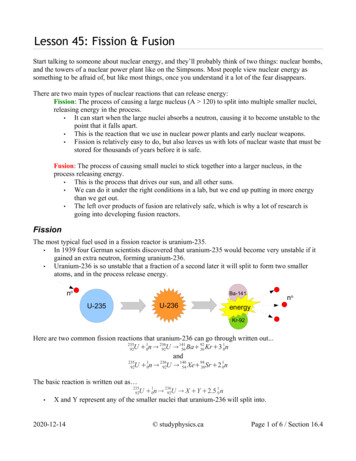
Transcription
Lesson 45: Fission & FusionStart talking to someone about nuclear energy, and they’ll probably think of two things: nuclear bombs,and the towers of a nuclear power plant like on the Simpsons. Most people view nuclear energy assomething to be afraid of, but like most things, once you understand it a lot of the fear disappears.There are two main types of nuclear reactions that can release energy:Fission: The process of causing a large nucleus (A 120) to split into multiple smaller nuclei,releasing energy in the process. It can start when the large nuclei absorbs a neutron, causing it to become unstable to thepoint that it falls apart. This is the reaction that we use in nuclear power plants and early nuclear weapons. Fission is relatively easy to do, but also leaves us with lots of nuclear waste that must bestored for thousands of years before it is safe.Fusion: The process of causing small nuclei to stick together into a larger nucleus, in theprocess releasing energy. This is the process that drives our sun, and all other suns. We can do it under the right conditions in a lab, but we end up putting in more energythan we get out. The left over products of fusion are relatively safe, which is why a lot of research isgoing into developing fusion reactors.FissionThe most typical fuel used in a fission reactor is uranium-235. In 1939 four German scientists discovered that uranium-235 would become very unstable if itgained an extra neutron, forming uranium-236. Uranium-236 is so unstable that a fraction of a second later it will split to form two smalleratoms, and in the process release energy.noBa-141U-236U-235noenergyKr-92Here are two common fission reactions that uranium-236 can go through written out.235123614192192U 0n 92U 56 Ba 36 Kr 3 0nand235123614094192U 0n 92U 54 Xe 38 Sr 2 0nThe basic reaction is written out as 23592 12361U 0n 92U X Y 2.5 0 nX and Y represent any of the smaller nuclei that uranium-236 will split into.2020-12-14 studyphysics.caPage 1 of 6 / Section 16.4
Some things to notice 1. Both reactions start the same when we add a single neutron to uranium-235, which formsuranium-236 for a split second.2. Barium-141, krypton-92, xenon-140, and strontium-94 are smaller nuclei that uranium-236could split into.3. At any point in the reaction the conservation laws of nucleons and charge are obeyed.4. In the first reaction three neutrons were ejected, while in the second reaction only two wereejected. Although it is possible for as many as 5 neutrons to be ejected in some fissionreactions, on average it is about 2.5 neutrons as shown in the basic reaction. You can’t reallyhave half a neutron, but we’re just looking at the average mathematically.5. These reactions are exothermic (they release energy).To keep this reaction going, do we need to keep on adding neutrons? Well, we could, but it takes energy to isolate neutrons and then throw them at the uranium-235,so this isn’t the best idea. We do have an average of 2.5 neutrons thrown off each reaction that is successful, so why notjust use those?That’s exactly what we do! If exactly one neutron gives rise to another reaction, the self sustaining reaction that results iscalled critical. Each reaction leads to one reaction afterwards. This is a “chain reaction”.Critical Nuclear ReactionReaction One235921U 0n 236921U X Y 2.5 0 n1 neutronReaction Two235921U 0n 236921U X Y 2.5 0 n1 neutronReaction Three235921U 10n 23692U X Y 2.5 0 nWe give the initial neutron to startReaction One. One neutron producedfrom Reaction One feeds ReactionTwo, while 1.5 neutrons fly away Reaction Two happens because of theneutron that was fed to it by ReactionOne. Now Reaction Two makes its ownneutrons, one of which feeds the nextreaction.The process is repeating again.1 neutronReaction Four2020-12-14235921U 0n 236921U X Y 2.5 0 n studyphysics.ca and again. One reaction causes onemore reaction to happen in a row for aslong as there is uranium.Page 2 of 6 / Section 16.4
If two or more neutrons give rise to more reactions, the increasing rate of reactions is calledsupercritical. Each reaction leads to multiple reactions afterwards.Supercritical Nuclear ReactionReaction 1Reaction 2Reaction 4 Reaction 3Reaction 5Reaction 6timeReaction 7Each reaction leads to multiple reactions, meaning that witheach “generation” of reactions the number or reactions isincreasing exponentially.There are a few situations when we want this to happen. in a nuclear bomb, since we want one reaction we kick offto result in a cascade of exponentially more and morereactions within a split second when a nuclear power plant is first being started up, until itreaches the number of reactions that we can keep going atthe same time. Then it will be stepped down to just acritical reaction.There is also a situation when we do not want a supercriticalreaction, which is when a nuclear power plant is going into ameltdown. This is what started to happen at the Chernobyl NuclearReactor in Ukraine.Illustration 1: ChernobylReactor Number Four.If less than one neutron gives rise to more reactions, the decreasing rate of reactions is calledsubcritical. For example, lets say you have four reactions, but the neutrons from only three of them feedlater reactions, and of those three only two continue, then down to one the reaction willeventually die out. This is what happens when you shut down a reactor.2020-12-14 studyphysics.caPage 3 of 6 / Section 16.4
Subcritical Nuclear ReactionReaction 1Reaction 2Reaction 3Reaction 4Reaction 5Reaction 6Reaction 7Reaction 8Reaction 10Reaction 11Reaction 12Reaction 13Reaction 9timeReaction 14Nuclear ReactorsReactors use control rods to control the rate of the reaction. Made from elements such as boron and cadmium, control rods are very good at absorbingneutrons. If a reaction is going supercritical, drop the control rods further into the core to absorbextra neutrons and the reaction slows to critical. If the reaction is going subcritical, pull the control rods out, which lets more neutrons reactand get more reactions going again to critical.Nuclear reactors had a problem identified in the 1920s-40s that needed to be figured out before reactorscould work. The 2.5 neutrons released in the fission process are moving really fast, in fact too fast to be ableto be absorbed by the next uranium-235 in the chain. We need to be able to slow them down. Something that slows down neutrons in a reactor iscalled a moderator. If you want something to slow you should hit it against something about the same size, so itwould be best if we could get these fast moving neutrons to hit some different neutrons. Unfortunately, naturally occurring neutrons are very unstable, so we’d be better off withsomething about the same size as neutrons. Hmmm, maybe protons!This leads to three possible materials that can be used as moderators.Moderator 1: WaterA cheap source of a bunch of protons is water! All those hydrogen atoms in water are made up of asingle proton orbited by an electron. The hydrogen in water are mostly hydrogen-1 atoms. Hydrogen-1 doesn't just slow down neutrons, they usually absorb neutrons. This preventsthem from going on to the next part of the reaction.1121 H 0 n 1 H2020-12-14 studyphysics.caPage 4 of 6 / Section 16.4
A way to get around this is to use enriched uranium. There are still some neutrons that just slow down, so we have to give them a better chance ofhitting a U-235 nucleus. We refine the uranium so it has higher amounts of U-235 nuclei in them. This increases theprobability of those few neutrons hitting the U-235 to keep the fission reaction critical. This method is used by reactors in the USA.Moderator 2: Heavy WaterSo, recall that if the hydrogen in a water molecule absorb a neutron, they go from H-1 to H-2. Thishydrogen with one proton and one neutron is so special it gets a name. deuterium. Since the hydrogen in the water molecules now have two extra neutrons (one on eachhydrogen), the water is atomically more heavy, so we often call it heavy water.Rather than starting with regular water in your reactor, intentionally put heavy water in at the start asthe moderator. Hydrogen-2 in the heavy water will not absorb many more neutrons. It will just let the neutronsflying around hit it and slow down. This way you can use regular uranium ore. CANDU (CANadian Deuterium Uranium) reactorsuse this method.Moderator 3: GraphiteHey, what happened to the water! It turns out graphite (carbon) works really well as a moderator. It is a popular method for building reactors in the former Soviet Union and Britain. There is one big problem if oxygen gets into the reactor, carbon can actually burst into flames(they’re basically giant BBQ briquettes). This is part ofwhat caused the explosion at Chernobyl.FusionBy the time the 1920's rolled around, physicists had figured outthat the Sun was made from about 73% hydrogen and 27% helium. The suggestion was made that maybe hydrogen nuclei fusetogether to form helium nuclei. This would fit, since four hydrogen nuclei (fourprotons) have just a little more mass than a heliumnucleus. It would make sense the mass that wasmissing after fusion would have been converted toenergy (E mc2). This very basic fusion, called a proton-proton chain, isthe source of energy for stars like our Sun.So why don’t we use fusion instead of fission here on Earth in ournuclear reactors? For each kilogram of fuel, fusion actually makesmore energy than fission, so it would make sense to build fusionreactors to supply us with energy. The problem is obvious if we think of where fusionIllustration 2: Proton-proton chain.naturally occurs. inside stars at immense pressure andImage courtesy of Borb.2020-12-14 studyphysics.caPage 5 of 6 / Section 16.4
temperature (around 14 million Kelvin). It is almost impossible to recreate these exact conditions on Earth in a reactor we build, socurrent research uses intense magnetic and electric fields, usually along with lasers.In 2014 scientists at the Lawrence Livermore National Laboratory produced a controlled fusionreaction with more output than input for the first time, but just barely! They used a fuel source the size of a pin head and only lasted for 150 ps, so it is only at theexperimental level.Unfortunately, we are pretty good at uncontrolled fusion. Thermonuclear weapons first use a fission device to create the initial temperature and pressureneeded to drive the fusion process where most of the energy comes from. These weapons can be built smaller and with more explosive energy than regular fission bombs.In 1989 Stanley Pons and Martin Fleischmann at the University of Utah claimed to have performedcold fusion that “anyone could do with a mayonnaise jar.” They skipped publishing their results and instead had a press conference to announce theirresults. It was later proved false when the experiment could not be reproduced.Homeworkp819 #2p824 #1, 4, 6, 8p826 #3, 5-8, 10, 12, 14, 16, 25, 302020-12-14 studyphysics.caPage 6 of 6 / Section 16.4
A way to get around this is to use enriched uranium. There are still some neutrons that just slow down, so we have to give them a better chance of hitting a U-235 nucleus. We refine the uranium so it has higher amounts of U-235 nuclei in them. This increases the probability of those few neutrons hitting the U-235 to keep the fission reaction critical.



